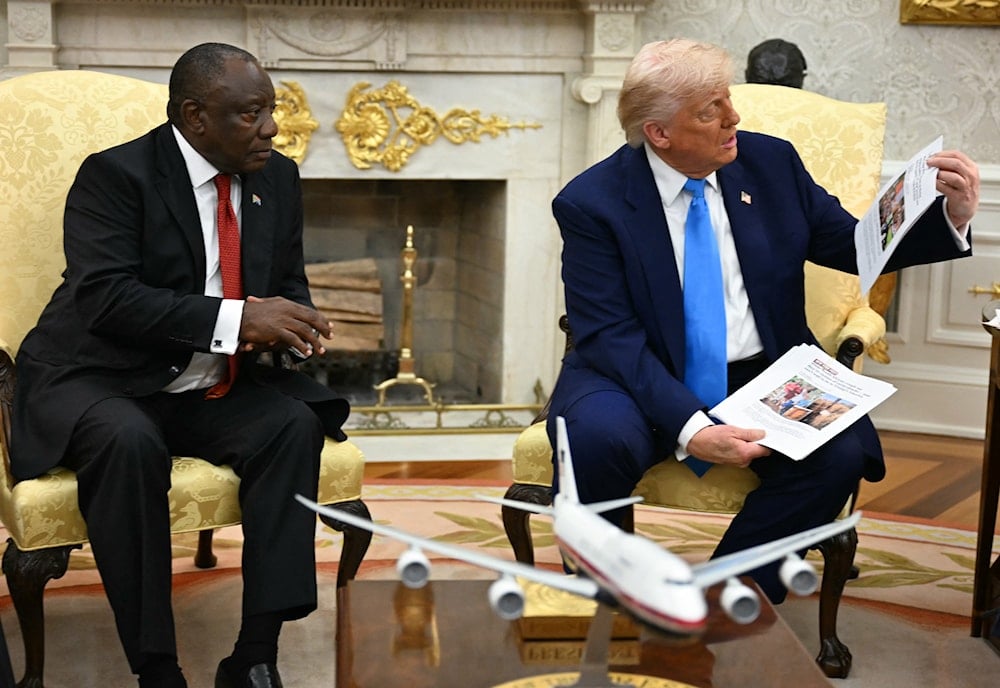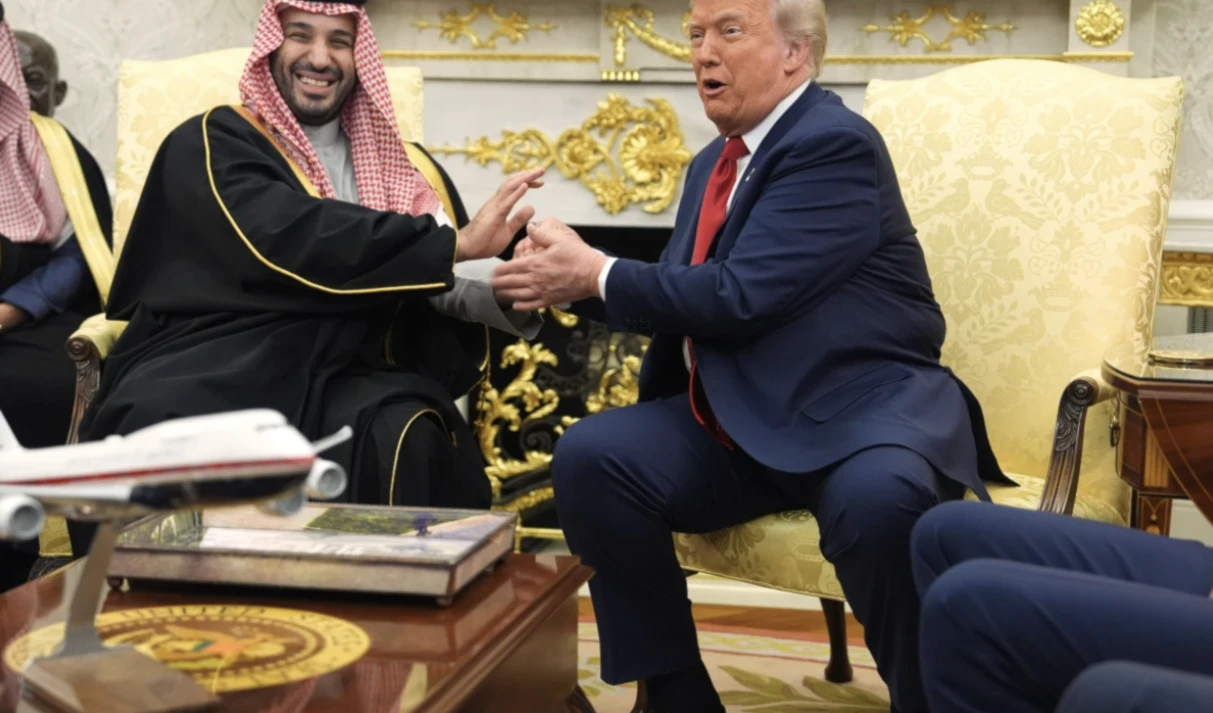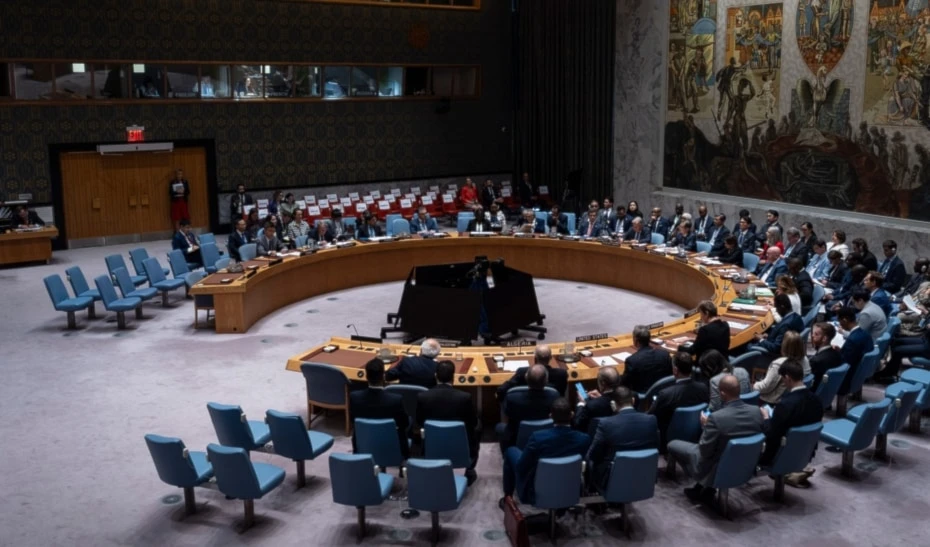Reuters debunks Trump's 'white genocide' claims in South Africa
Again, the US president has repeated claims of a "white farmer genocide" in South Africa, misrepresented land reform policies, and shown misleading images.
-

US President Donald Trump shows pictures and articles as he meets with South African President Cyril Ramaphosa in the Oval Office of the White House in Washington, DC, on May 21, 2025. (AFP)
During a contentious Oval Office meeting with South African President Cyril Ramaphosa, US President Donald Trump repeated a series of debunked claims regarding the treatment of white South African farmers, Reuters reported.
The meeting featured interruptions by Trump and the presentation of a video containing years-old inflammatory clips of South African political figures, which have circulated widely on social media and far-right platforms.
Debunking the ‘white genocide’ narrative
One of Trump’s central assertions was the existence of a "genocide" targeting white South African farmers. This claim has been widely discredited by legal rulings, statistical data, and South African authorities. It originated in far-right circles and has been amplified by online groups and figures, such as Elon Musk.
South Africa recorded 26,232 murders in 2024. Of these, 44 were linked to farming communities, with only eight of the victims being farmers. Most murder victims in the country are Black South Africans.
Even data collected by white farmers themselves does not support the narrative of ethnic cleansing. The TLU-SA, an Afrikaner farmers' union, reported 1,363 murders of white farmers since 1990, an average of about 40 per year, representing far less than 1% of annual homicides.
Earlier this year, the Western Cape High Court ruled that claims of white genocide were “clearly imagined and not real,” citing the lack of credible evidence.
Read more: 'Misrepresentation': NYT refutes Trump's S.Africa white genocide video
Misrepresentation of land expropriation policies
Trump also claimed that white farmers were having their land seized without compensation in a government-backed initiative.
In reality, the South African government has long pursued voluntary land reform to correct apartheid-era inequalities. Despite these efforts, white South Africans, who make up less than 8% of the population, still own around 75% of privately held farmland.
In January, Ramaphosa signed a law enabling land expropriation without compensation under exceptional circumstances and only in the public interest. However, this law has not yet been implemented, and the government's preference remains to negotiate with landowners.
No evidence EFF initiated land invasions
Moreover, the opening scene of the White House video shows Economic Freedom Fighters (EFF) leader Julius Malema in South Africa's parliament announcing that "people are going to occupy land. We require no permission from ... the president".
The video also shows another clip of Malema pledging to expropriate land.
While some land has been illegally occupied over the years, the land is usually unused and there is no evidence the EFF initiated any land invasions.
Context of the ‘Kill the Boer’ song
Another focal point of Trump’s presentation was the song “Kill the Boer,” shown in a video clip of Malema.
Trump described it as a call to murder Afrikaners. However, South African courts have ruled multiple times that the song is a liberation-era chant, not a literal incitement to violence.
In response to the meeting, the EFF released a statement clarifying the chant as symbolic of resistance against historical systems of racial oppression.
"We didn't know that we would form part of those theatrics to try and justify the existence of a white genocide that is obviously not occurring in South Africa," said EFF spokesperson Sinawo Thambo.
Misuse of visual evidence
Trump's video also showed rows of white crosses along a highway, which he described as “burial sites” for murdered white farmers.
However, the footage was taken during a 2020 protest following the killing of a farming couple and did not depict actual graves.
Organizers of the demonstration stated that the crosses symbolized those who had died over time, not specific burials.
Dispute over video credibility
During the following day’s White House press briefing, NBC News correspondent Yamiche Alcindor challenged Press Secretary Karoline Leavitt on the authenticity of the video.
Alcindor noted reports that the crosses were part of a symbolic protest rather than actual burial sites.
“We know that that was not true and that the video wasn’t true,” Alcindor said, prompting a heated exchange.
Alcindor pressed further, questioning the protocols used to verify sensitive material shown by the US government.
Leavitt defended the administration’s stance, stating, “The video shows crosses that represent the dead bodies of people who were racially persecuted by their government.”
She cited The Associated Press, claiming it had published an image of the same monument with a caption affirming it was a memorial for White South African farmers killed in farm murders.
Ramaphosa surprised by Trump’s claim
During the Oval Office exchange, Ramaphosa appeared surprised by Trump’s claim, questioning the location and validity of the burial sites.
“Have they told you where that is, Mr. President?” Ramaphosa asked. “I’d like to know where that is. Because this I’ve never seen.”
Trump responded, “I mean, it’s in South Africa, that’s where.”
Ramaphosa replied, “We need to find out.”
The Guardian reported that many South Africans commended Ramaphosa for maintaining his composure when Trump confronted him in the Oval Office with a video intended to support his unfounded claims of a "genocide" against white Afrikaner farmers.
Screengrab from the Democratic Republic of Congo
In another instance, Trump held up a photo of people lifting body bags, claiming it depicted murdered white South African farmers.
The image, however, was a Reuters screengrab from the Democratic Republic of Congo, showing humanitarian workers during a burial following fighting in Goma. It was misattributed in a blog post and later presented by Trump as evidence of farm murders in South Africa.

 6 Min Read
6 Min Read










